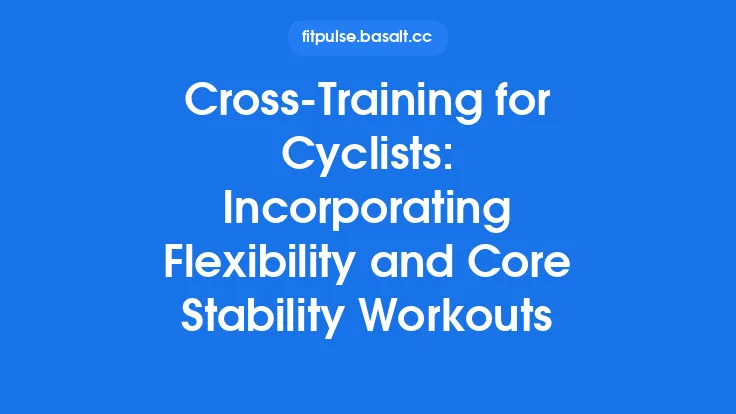When you step onto the floor for a home workout, the most powerful tools you have are not the dumbbells or the resistance bands, but the way you position your body and the way you engage the muscles that stabilize it. Good posture and purposeful core activation act like an invisible scaffolding that protects your joints, maximizes the effectiveness of each movement, and reduces the risk of strain over the long term. By learning to recognize, correct, and maintain optimal alignment, you turn any living‑room, garage, or balcony into a space where you can train confidently and safely.
Understanding the Role of Posture in Home Exercise
Posture is more than a static “standing tall” picture; it is a dynamic relationship among the spine, pelvis, shoulders, and hips that changes with every repetition. When the skeletal chain is properly aligned, the muscles work in their optimal length‑tension range, allowing forces to be transferred efficiently. Misalignment—such as excessive lumbar lordosis, anterior pelvic tilt, or rounded shoulders—creates compensatory patterns that overload secondary structures (e.g., facet joints, ligaments, and intervertebral discs).
Key concepts to keep in mind:
| Anatomical Segment | Ideal Alignment | Common Deviation | Primary Consequence |
|---|---|---|---|
| Spine | Neutral curvature (maintains natural cervical, thoracic, lumbar curves) | Hyper‑extension or excessive flexion | Increased disc pressure, reduced spinal stability |
| Pelvis | Slight anterior tilt balanced by posterior tilt of the sacrum | Extreme anterior tilt (hip‑flexor dominance) or posterior tilt (hamstring dominance) | Altered lumbar curve, hamstring strain, hip impingement |
| Shoulders | Scapulae retracted and depressed, glenohumeral joint neutral | Protracted, elevated shoulders | Impingement, reduced shoulder power |
| Knees | Aligned over the second toe, slight flexion in static stance | Valgus (knees inward) or varus (knees outward) | Patellofemoral stress, ligament strain |
When you train at home, you often lack the external cues that a gym environment provides (mirrored walls, spotters, trainers). Developing an internal sense of these alignments is therefore essential for safety.
Key Principles of Core Engagement
The “core” is frequently described as a single muscle, but it is actually a coordinated network that includes:
- Transversus abdominis (TrA) – the deepest abdominal layer that acts like a corset.
- Internal and external obliques – provide rotational stability and lateral flexion.
- Rectus abdominis – contributes to trunk flexion.
- Multifidus – deep spinal stabilizers that segmentally control vertebral motion.
- Pelvic floor and diaphragm – work in concert with the abdominal wall to regulate intra‑abdominal pressure.
Effective core engagement follows three interrelated principles:
- Brace, Don’t Suck – Imagine gently pulling your belly button toward your spine while maintaining normal breathing. This creates a “bracing” pressure that stabilizes the lumbar spine without collapsing the ribcage.
- Maintain Intra‑Abdominal Pressure (IAP) – A modest increase in IAP acts like an internal pneumatic support, protecting the spine during loaded movements (e.g., squats, deadlifts). The pressure should be enough to feel a firm “core wall” but not so high that it impedes breathing.
- Synchronize with the Diaphragm – Inhale to expand the ribcage, then exhale while engaging the core. This coordinated breath‑core pattern enhances spinal rigidity and reduces shear forces.
Common Postural Faults and How to Fix Them
| Fault | Visual Cue | Correction Strategy |
|---|---|---|
| Excessive lumbar arch (hyperlordosis) | Lower back pushes outward, pelvis tilts forward | Posterior pelvic tilt drill: Lie on your back, knees bent, gently press the lower back into the floor while engaging the TrA. Practice “hip hinge” in standing, keeping the pelvis neutral. |
| Rounded shoulders | Scapulae drift forward, chest collapses | Scapular retraction: Stand with arms at sides, pull elbows back while squeezing shoulder blades together. Use a light resistance band around the upper back to reinforce the cue during push‑ups or rows. |
| Knee valgus during squats | Knees collapse inward, toes point forward | Hip‑abductor activation: Perform side‑lying clamshells or banded monster walks. During the squat, push the knees outward as if “spreading the floor” with your feet. |
| Forward head posture | Chin juts forward, cervical spine flexed | Chin tuck: Gently tuck the chin toward the throat while keeping the eyes forward. Practice this while standing and during overhead movements. |
| Over‑reliance on hip flexors | Tight feeling in the front of the hips, limited hip extension | Hip‑flexor stretch + glute activation: Perform a kneeling hip‑flexor stretch, then activate glutes with a “glute bridge” before moving into lunges or deadlifts. |
Each correction should be practiced in isolation first (e.g., wall‑supported squat) before integrating into full‑range movements.
Practical Techniques for Activating the Core
- Dead‑Bug Progression
- Setup: Lie on your back, arms extended toward the ceiling, knees bent at 90°.
- Action: Slowly lower the right arm overhead while extending the left leg, keeping the lower back flat. Return to start and repeat on the opposite side.
- Core Cue: Keep the lumbar spine pressed into the floor; imagine a “belt” tightening around your waist.
- Plank Variations with Bracing
- Standard Plank: Forearms on the floor, elbows under shoulders, body in a straight line.
- Cue: Draw the belly button toward the spine, maintain a neutral neck, and keep the shoulders away from the ears.
- Progression: Add a “dead‑bug” leg lift or shoulder tap while preserving the brace.
- Pallof Press (Band or Cable)
- Setup: Anchor a resistance band at chest height, stand perpendicular to the anchor.
- Action: Hold the band with both hands, extend arms straight in front, resist rotation.
- Core Cue: Engage the TrA and obliques to prevent the torso from rotating. This anti‑rotational exercise is excellent for stabilizing the spine during unilateral movements like single‑leg deadlifts.
- Bird‑Dog
- Setup: On hands and knees, maintain a neutral spine.
- Action: Extend opposite arm and leg, hold for 2–3 seconds, then return.
- Cue: Keep the hips level; avoid arching the back. The movement trains the multifidus and gluteus maximus in a coordinated fashion.
- Diaphragmatic Breathing with Core Engagement
- Technique: Inhale deeply into the belly, allowing the abdomen to expand. On the exhale, gently contract the TrA as if “zipping up a tight jacket.” Use this pattern during the concentric phase of lifts (e.g., pressing up in a push‑up) to maximize spinal stability.
Integrating Posture and Core Cues into Popular Home Workouts
| Exercise | Primary Postural Concern | Core Cue Integration |
|---|---|---|
| Bodyweight Squat | Knee tracking, hip hinge | Initiate with a “braced” core, push knees outward, keep chest lifted. |
| Push‑Up | Shoulder protraction, lumbar sag | Retract scapulae, maintain a straight line, engage core before lowering. |
| Lunge (Forward/Reverse) | Hip flexor dominance, knee valgus | Step back to reduce hip‑flexor load, brace core, keep torso upright. |
| Glute Bridge | Pelvic tilt | Start with a posterior pelvic tilt, squeeze glutes, keep core engaged to avoid lumbar over‑extension. |
| Plank‑to‑Push‑Up | Spinal sag, shoulder elevation | Maintain a neutral spine throughout the transition, keep core tight, avoid letting hips drop. |
When you embed these cues into each set, the habit of checking alignment becomes automatic, even when you’re fatigued.
Self‑Assessment and Feedback Tools
- Wall‑Supported Checks: Stand with your back against a wall, heels 2–3 inches away. Your head, shoulder blades, and buttocks should touch the wall. This provides a quick reference for neutral spine and pelvic position.
- Mirror Audits: Use a full‑length mirror (or a phone camera) to observe alignment from the side and front. Look for the “straight line” from ear to shoulder to hip.
- Video Playback: Record a set of an exercise from multiple angles. Slow‑motion playback reveals subtle deviations (e.g., knee drift, shoulder elevation).
- Tactile Feedback: Place a small towel roll under the lumbar spine while lying supine; if you can feel it flatten during a plank, you’re maintaining neutral lumbar alignment.
- Proprioceptive Bands: Light resistance bands around the thighs during squats give immediate feedback when the knees move inward, prompting you to correct the pattern.
Progressive Strategies for Maintaining Safe Form
- Start with Low Load, High Control – Master the movement pattern with body weight or light resistance before adding load.
- Add “Micro‑Load” Challenges – Introduce a slight pause at the most demanding joint angle (e.g., bottom of a squat) while keeping the core braced. This forces the stabilizers to work harder without increasing external weight.
- Implement “Form‑First” Sets – Perform the first two sets of any exercise focusing solely on posture and core engagement; only after achieving consistent form should you increase reps or load.
- Periodize Core Work – Cycle through phases: (a) Activation (light core drills), (b) Stability (anti‑rotation and anti‑flexion exercises), (c) Strength (weighted planks, Pallof presses). This systematic approach builds a robust core foundation over weeks.
- Schedule “Form Audits” – Every 4–6 weeks, dedicate a short session to re‑evaluate your posture cues across all major lifts. Adjust as needed to accommodate any mobility changes.
Lifestyle Factors that Support Good Posture and Core Strength
- Daily Movement Breaks: Stand, stretch, and perform a quick “standing brace” (engage core, align spine) every hour, especially if you work at a desk.
- Sleep Ergonomics: Use a pillow that maintains neutral cervical alignment; avoid sleeping on the stomach, which encourages anterior pelvic tilt.
- Mindful Breathing: Practice diaphragmatic breathing throughout the day; this reinforces the core‑diaphragm connection that you’ll later use during workouts.
- Hydration and Nutrition: Adequate hydration supports intervertebral disc health, while protein intake aids muscle recovery, including the deep stabilizers.
- Footwear Awareness: Even at home, wearing supportive shoes (or a stable barefoot stance) helps maintain proper ankle alignment, which cascades up to the knees and hips.
Building a Safer Home Exercise Habit
By consistently applying the posture‑correction and core‑engagement principles outlined above, you create a self‑reinforcing loop: better alignment leads to more efficient force transfer, which reduces fatigue and injury risk, which in turn encourages you to train more regularly. The key is to treat alignment and core activation not as optional “extras” but as integral parts of every repetition.
Start small—pick one exercise, focus on the cues, and use a mirror or video for feedback. As the habit solidifies, expand the approach to the rest of your routine. Over weeks and months, you’ll notice smoother movements, stronger performance, and a training environment that feels as safe and supportive as any commercial gym—right from the comfort of your own home.





